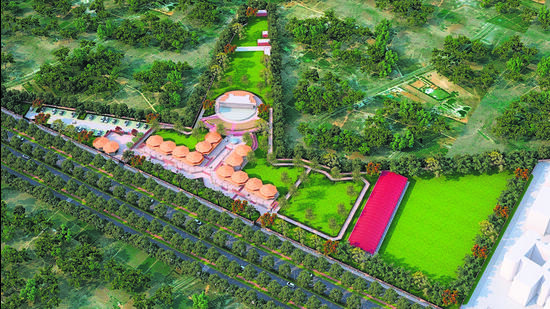Our Terms & Conditions | Our Privacy Policy
Kalagram — a mini India of crafts and culture to come up in Dwarka Sector 7 | Latest News Delhi
Artistically designed huts dedicated to the culture of different states and regions across India, with space for artisans to exhibit and sell their handicrafts, an amphitheatre for screenings and musical performances, and a culinary centre — an elaborate village habitat-themed hub for all things art and heritage is set to come up in the city soon, officials aware of the matter said.
An artist’s impression of the planned project. (HT Photo)
Named Kalagram (which translates to village of art, adhering to the established theme), the Central Public Works Department will develop the cultural complex in Dwarka’s Sector 7 within the campus of the Centre for Cultural Resources and Training (CCRT).
The project, which was cleared by the Union ministry of culture in 2023, has already received a funding sanction of ₹1 crore. The construction work is expected to complete within a year, said officials. CPWD has already floated tenders for the same.
“Once operational, the complex is expected to become a major attraction not only for Delhi residents but also for tourists and artists from across the country. It will serve as a platform for rural artisans to gain urban exposure, create economic opportunities, and enable cross-cultural learning,” said CCRT chairman, Vinod Narayan Indurkar.
The initiative is part of the government’s larger Azadi Ka Amrit Mahotsav (AKAM) campaign — a tribute to 75 years of Indian independence — and is being developed with a vision of showcasing the country’s diverse traditional and contemporary art forms, Indurkar added.
According to minutes from the 2023 board meeting, Kalagram’s focus will be on “imbibing architectural, aesthetic, historic, environmental, archaeological and even spiritual and symbolic values embedded in our heritage.”
Spanning over 2.3 acres, Kalagram is being envisioned as a “mini India”, offering a panoramic view of the cultural mosaic that defines the nation. The complex will house 12 artistically designed huts, each dedicated to a different region of India and reflecting its unique craft, textile, and art traditions. These huts will provide space to artisans from across the country to exhibit and sell their handicrafts.
In addition to these permanent structures, it will also feature temporary kiosks, an amphitheatre with a seating capacity of 400 people, and spaces for exhibitions, workshops, and live performances. It will be functional throughout the year to maintain consistent footfall and public engagement. There are also provisions for multiple conference rooms, and in the next phase of development, a hostel facility is expected to be added to accommodate artists and participants.
“We are in contact with artistes and performers from across the country, who will be invited for live performances and shows every day. We want to develop Kalagram as a lively and active space where people can spend time. That is why we are also developing a large open cafeteria,” said Indurkar.
He added that the walls and other spaces within Kalagram will be adorned with handicraft and folk art from different regions across the country.
The Delhi Urban Art Commission (DUAC) last month granted design and development approval for the project. Officials familiar with the matter said the project has been carefully designed to blend into the urban character of Dwarka while adding a distinct cultural identity to the area.
The detailed project report (DPR) states that the project has been conceived on the theme of a “village habitat”. From the entrance structures to the material used, all elements will be in sync with a typical village environment, officials said, which will include walls finished with mud plaster, and roof of huts made with corrugated bamboo sheets.
“The exhibition huts have been placed at different levels in such a way to have the OAT as a contiguous part of the display area, thus enabling the visitors to enjoy cultural activities being arranged in the OAT from time-to-time. Site planning has been done in such a way that minimum trees will have to be cut,” the DPR mentions.
Officials from the culture ministry said that Kalagram will not just be a tourist destination, but a functional cultural hub, serving students, art practitioners, scholars, and general visitors as a “living ecosystem of culture and learning”, adding that the project will draw from India’s ancient gurukul system in its layout and learning modules.
Established in 1979, CCRT has been promoting India’s intangible heritage through educational programmes, scholarships for young artists, and its popular Virasat Kamaladevi Festival, which honours the contributions of cultural stalwart Kamaladevi Chattopadhyay.
Images are for reference only.Images and contents gathered automatic from google or 3rd party sources.All rights on the images and contents are with their legal original owners.



Comments are closed.